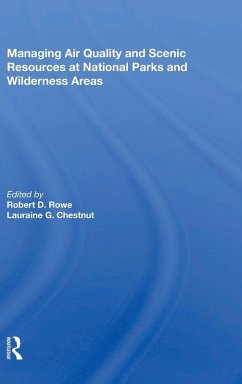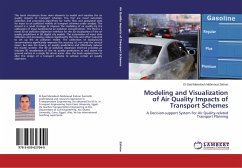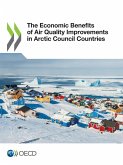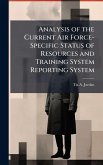Robert D. Rowe
Managing Air Quality and Scenic Resources at National Parks and Wilderness Areas
Robert D. Rowe
Managing Air Quality and Scenic Resources at National Parks and Wilderness Areas
- Gebundenes Buch
- Merkliste
- Auf die Merkliste
- Bewerten Bewerten
- Teilen
- Produkt teilen
- Produkterinnerung
- Produkterinnerung
This book is an outcome of the Visual Values Workshop in 1982. It presents the ongoing research on state-of-the-art techniques and applications to address the human perception of changes in visual aesthetic resources and to assign psychological, social, and economic measures of value to visitors.
Andere Kunden interessierten sich auch für
![Urban air quality modeling and management in Hanoi, Vietnam Urban air quality modeling and management in Hanoi, Vietnam]() Ngo Tho HungUrban air quality modeling and management in Hanoi, Vietnam52,99 €
Ngo Tho HungUrban air quality modeling and management in Hanoi, Vietnam52,99 €![Ecology of Industrialization and Air Quality Ecology of Industrialization and Air Quality]() Harrison EkohEcology of Industrialization and Air Quality41,99 €
Harrison EkohEcology of Industrialization and Air Quality41,99 €![Modeling and Visualization of Air Quality Impacts of Transport Schemes Modeling and Visualization of Air Quality Impacts of Transport Schemes]() El-Said Mamdouh Mahmoud ZahranModeling and Visualization of Air Quality Impacts of Transport Schemes53,99 €
El-Said Mamdouh Mahmoud ZahranModeling and Visualization of Air Quality Impacts of Transport Schemes53,99 €![The Economic Benefits of Air Quality Improvements in Arctic Council Countries The Economic Benefits of Air Quality Improvements in Arctic Council Countries]() OecdThe Economic Benefits of Air Quality Improvements in Arctic Council Countries26,99 €
OecdThe Economic Benefits of Air Quality Improvements in Arctic Council Countries26,99 €![Governing Metropolitan Areas Governing Metropolitan Areas]() David K. HamiltonGoverning Metropolitan Areas187,99 €
David K. HamiltonGoverning Metropolitan Areas187,99 €![Analysis of the Current Air Force-Specific Status of Resources and Training System Reporting System Analysis of the Current Air Force-Specific Status of Resources and Training System Reporting System]() Tia A JordanAnalysis of the Current Air Force-Specific Status of Resources and Training System Reporting System28,99 €
Tia A JordanAnalysis of the Current Air Force-Specific Status of Resources and Training System Reporting System28,99 €![China in Revolution China in Revolution]() Mark SeldenChina in Revolution167,99 €
Mark SeldenChina in Revolution167,99 €-
-
-
This book is an outcome of the Visual Values Workshop in 1982. It presents the ongoing research on state-of-the-art techniques and applications to address the human perception of changes in visual aesthetic resources and to assign psychological, social, and economic measures of value to visitors.
Produktdetails
- Produktdetails
- Verlag: Routledge
- Seitenzahl: 336
- Erscheinungstermin: 17. Juni 2019
- Englisch
- Abmessung: 235mm x 157mm x 23mm
- Gewicht: 638g
- ISBN-13: 9780367020224
- ISBN-10: 036702022X
- Artikelnr.: 57109910
- Herstellerkennzeichnung
- Libri GmbH
- Europaallee 1
- 36244 Bad Hersfeld
- gpsr@libri.de
- Verlag: Routledge
- Seitenzahl: 336
- Erscheinungstermin: 17. Juni 2019
- Englisch
- Abmessung: 235mm x 157mm x 23mm
- Gewicht: 638g
- ISBN-13: 9780367020224
- ISBN-10: 036702022X
- Artikelnr.: 57109910
- Herstellerkennzeichnung
- Libri GmbH
- Europaallee 1
- 36244 Bad Hersfeld
- gpsr@libri.de
Rowe, Robert D.
Foreword
Preface
Introduction
Defining the Experience
Defining the Recreation Experience
Shaping the Visual Experience: Historic Origins of Wilderness and Desert Aesthetic
Interpretation and Visitor Values
Measuring Visual Perceptions
Human Perception of Visual Air Quality (Layered Haze)
Effects of Visual Range on the Beauty of National Parks and Wilderness Area Vistas
Implications of NCAR's Urban Visual Air Quality Assessment Method for Pristine Areas
Psychophysics, Visibility, and Perceived Atmospheric Transparency
Visual Resource Management Systems
The Bureau of Land Management's Visual Resource Management System
Assessing the Reliability, Validity and Generalizability of Observer
Based Visual Impact Assessment Methods for the Western United States
Objective Evaluation of Visual Values
Social and Psychological Approaches to Value Assessment
A Role Theoretic Analysis of Scenic Quality Judgments
Visual Air Quality Values: Public Input and Informed Choice
Social Research Methods for Public Land Managers
An Examination of Methodologies for Assessing the Value of Visibility
Two Examples of Psychological Assessment of Visual Values
Assessing the Effect of Visual Air Quality Degradation on Visitor Enjoyment
Potential Contributions of Canonical Analysis to Visual Value Research
Altering the Visual Quality of a Recreation Resource and Activity Displacement
Economic Approaches to Value Assessment
The Value to Visitors of Improving Visibility at Mesa Verde and Great Smoky National Parks
Economic Valuation of Potential Scenic Degradation at Bryce Canyon National Park
Priorities for Economic Analysis of Visibility Values
Existence and Bequest Value
Existence Value in a Total Valuation Framework
Unrevealed Extramarket Values: Values Outside the Normal Range of Consumer Choices
Management Perspectives and Case Studies
Managing Our Visual Resources
The Importance of Visibility Protection in the National Parks and Wilderness
Protection of the Visual Experience in the Flat Tops Wilderness
The Lake Tahoe Environmental Thresholds Study
Conclusions and Future Directions
Preface
Introduction
Defining the Experience
Defining the Recreation Experience
Shaping the Visual Experience: Historic Origins of Wilderness and Desert Aesthetic
Interpretation and Visitor Values
Measuring Visual Perceptions
Human Perception of Visual Air Quality (Layered Haze)
Effects of Visual Range on the Beauty of National Parks and Wilderness Area Vistas
Implications of NCAR's Urban Visual Air Quality Assessment Method for Pristine Areas
Psychophysics, Visibility, and Perceived Atmospheric Transparency
Visual Resource Management Systems
The Bureau of Land Management's Visual Resource Management System
Assessing the Reliability, Validity and Generalizability of Observer
Based Visual Impact Assessment Methods for the Western United States
Objective Evaluation of Visual Values
Social and Psychological Approaches to Value Assessment
A Role Theoretic Analysis of Scenic Quality Judgments
Visual Air Quality Values: Public Input and Informed Choice
Social Research Methods for Public Land Managers
An Examination of Methodologies for Assessing the Value of Visibility
Two Examples of Psychological Assessment of Visual Values
Assessing the Effect of Visual Air Quality Degradation on Visitor Enjoyment
Potential Contributions of Canonical Analysis to Visual Value Research
Altering the Visual Quality of a Recreation Resource and Activity Displacement
Economic Approaches to Value Assessment
The Value to Visitors of Improving Visibility at Mesa Verde and Great Smoky National Parks
Economic Valuation of Potential Scenic Degradation at Bryce Canyon National Park
Priorities for Economic Analysis of Visibility Values
Existence and Bequest Value
Existence Value in a Total Valuation Framework
Unrevealed Extramarket Values: Values Outside the Normal Range of Consumer Choices
Management Perspectives and Case Studies
Managing Our Visual Resources
The Importance of Visibility Protection in the National Parks and Wilderness
Protection of the Visual Experience in the Flat Tops Wilderness
The Lake Tahoe Environmental Thresholds Study
Conclusions and Future Directions
Foreword
Preface
Introduction
Defining the Experience
Defining the Recreation Experience
Shaping the Visual Experience: Historic Origins of Wilderness and Desert Aesthetic
Interpretation and Visitor Values
Measuring Visual Perceptions
Human Perception of Visual Air Quality (Layered Haze)
Effects of Visual Range on the Beauty of National Parks and Wilderness Area Vistas
Implications of NCAR's Urban Visual Air Quality Assessment Method for Pristine Areas
Psychophysics, Visibility, and Perceived Atmospheric Transparency
Visual Resource Management Systems
The Bureau of Land Management's Visual Resource Management System
Assessing the Reliability, Validity and Generalizability of Observer
Based Visual Impact Assessment Methods for the Western United States
Objective Evaluation of Visual Values
Social and Psychological Approaches to Value Assessment
A Role Theoretic Analysis of Scenic Quality Judgments
Visual Air Quality Values: Public Input and Informed Choice
Social Research Methods for Public Land Managers
An Examination of Methodologies for Assessing the Value of Visibility
Two Examples of Psychological Assessment of Visual Values
Assessing the Effect of Visual Air Quality Degradation on Visitor Enjoyment
Potential Contributions of Canonical Analysis to Visual Value Research
Altering the Visual Quality of a Recreation Resource and Activity Displacement
Economic Approaches to Value Assessment
The Value to Visitors of Improving Visibility at Mesa Verde and Great Smoky National Parks
Economic Valuation of Potential Scenic Degradation at Bryce Canyon National Park
Priorities for Economic Analysis of Visibility Values
Existence and Bequest Value
Existence Value in a Total Valuation Framework
Unrevealed Extramarket Values: Values Outside the Normal Range of Consumer Choices
Management Perspectives and Case Studies
Managing Our Visual Resources
The Importance of Visibility Protection in the National Parks and Wilderness
Protection of the Visual Experience in the Flat Tops Wilderness
The Lake Tahoe Environmental Thresholds Study
Conclusions and Future Directions
Preface
Introduction
Defining the Experience
Defining the Recreation Experience
Shaping the Visual Experience: Historic Origins of Wilderness and Desert Aesthetic
Interpretation and Visitor Values
Measuring Visual Perceptions
Human Perception of Visual Air Quality (Layered Haze)
Effects of Visual Range on the Beauty of National Parks and Wilderness Area Vistas
Implications of NCAR's Urban Visual Air Quality Assessment Method for Pristine Areas
Psychophysics, Visibility, and Perceived Atmospheric Transparency
Visual Resource Management Systems
The Bureau of Land Management's Visual Resource Management System
Assessing the Reliability, Validity and Generalizability of Observer
Based Visual Impact Assessment Methods for the Western United States
Objective Evaluation of Visual Values
Social and Psychological Approaches to Value Assessment
A Role Theoretic Analysis of Scenic Quality Judgments
Visual Air Quality Values: Public Input and Informed Choice
Social Research Methods for Public Land Managers
An Examination of Methodologies for Assessing the Value of Visibility
Two Examples of Psychological Assessment of Visual Values
Assessing the Effect of Visual Air Quality Degradation on Visitor Enjoyment
Potential Contributions of Canonical Analysis to Visual Value Research
Altering the Visual Quality of a Recreation Resource and Activity Displacement
Economic Approaches to Value Assessment
The Value to Visitors of Improving Visibility at Mesa Verde and Great Smoky National Parks
Economic Valuation of Potential Scenic Degradation at Bryce Canyon National Park
Priorities for Economic Analysis of Visibility Values
Existence and Bequest Value
Existence Value in a Total Valuation Framework
Unrevealed Extramarket Values: Values Outside the Normal Range of Consumer Choices
Management Perspectives and Case Studies
Managing Our Visual Resources
The Importance of Visibility Protection in the National Parks and Wilderness
Protection of the Visual Experience in the Flat Tops Wilderness
The Lake Tahoe Environmental Thresholds Study
Conclusions and Future Directions








